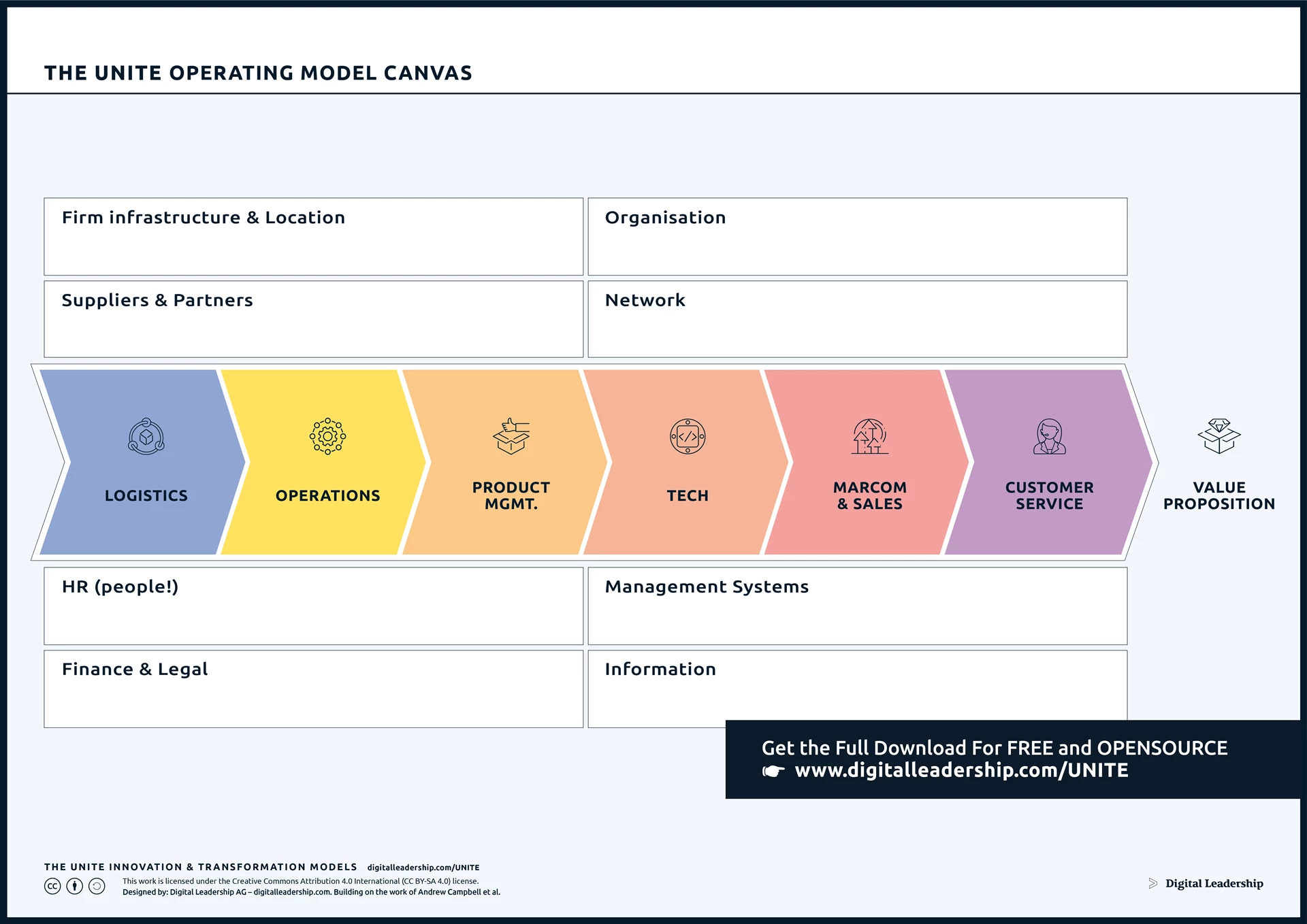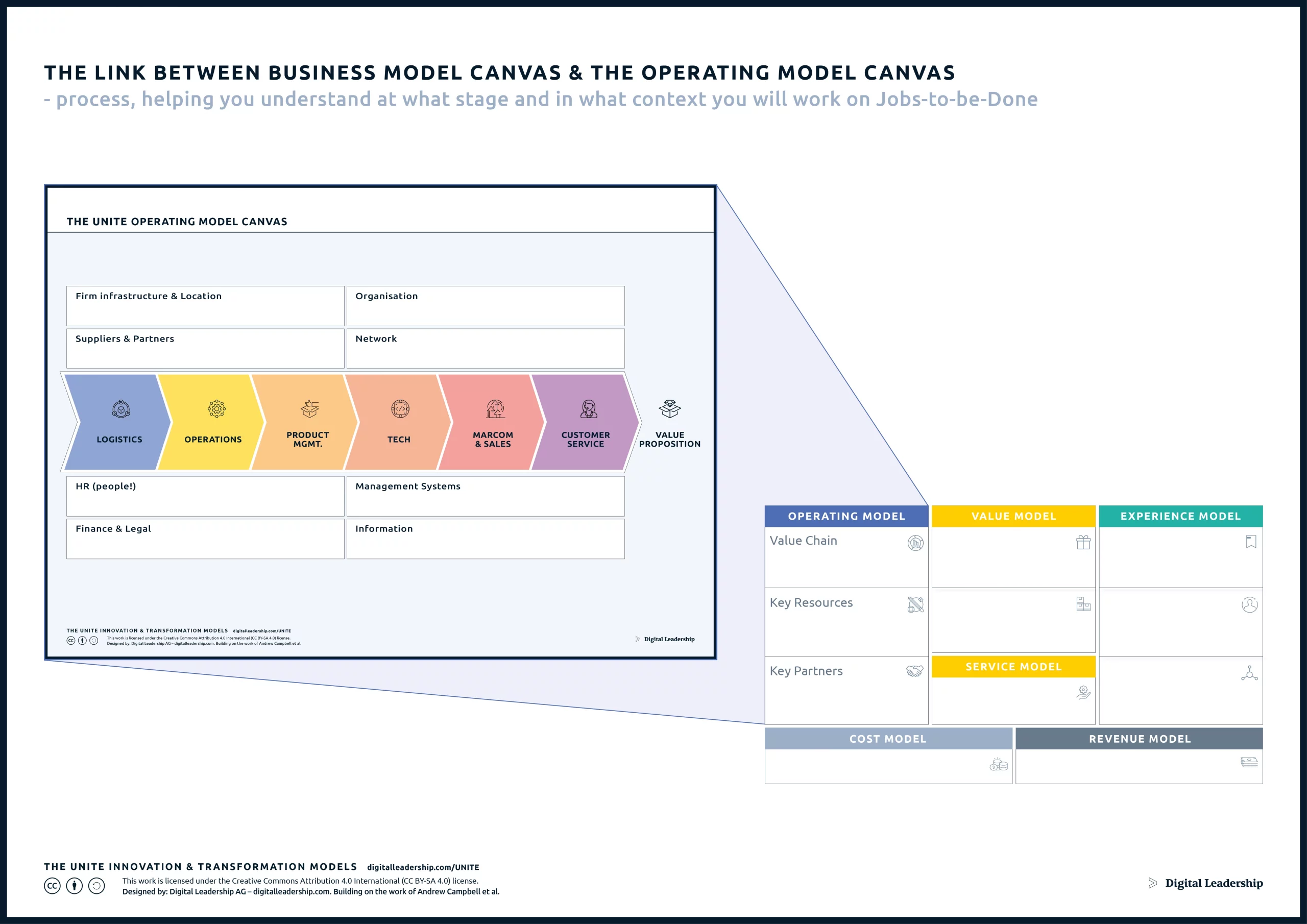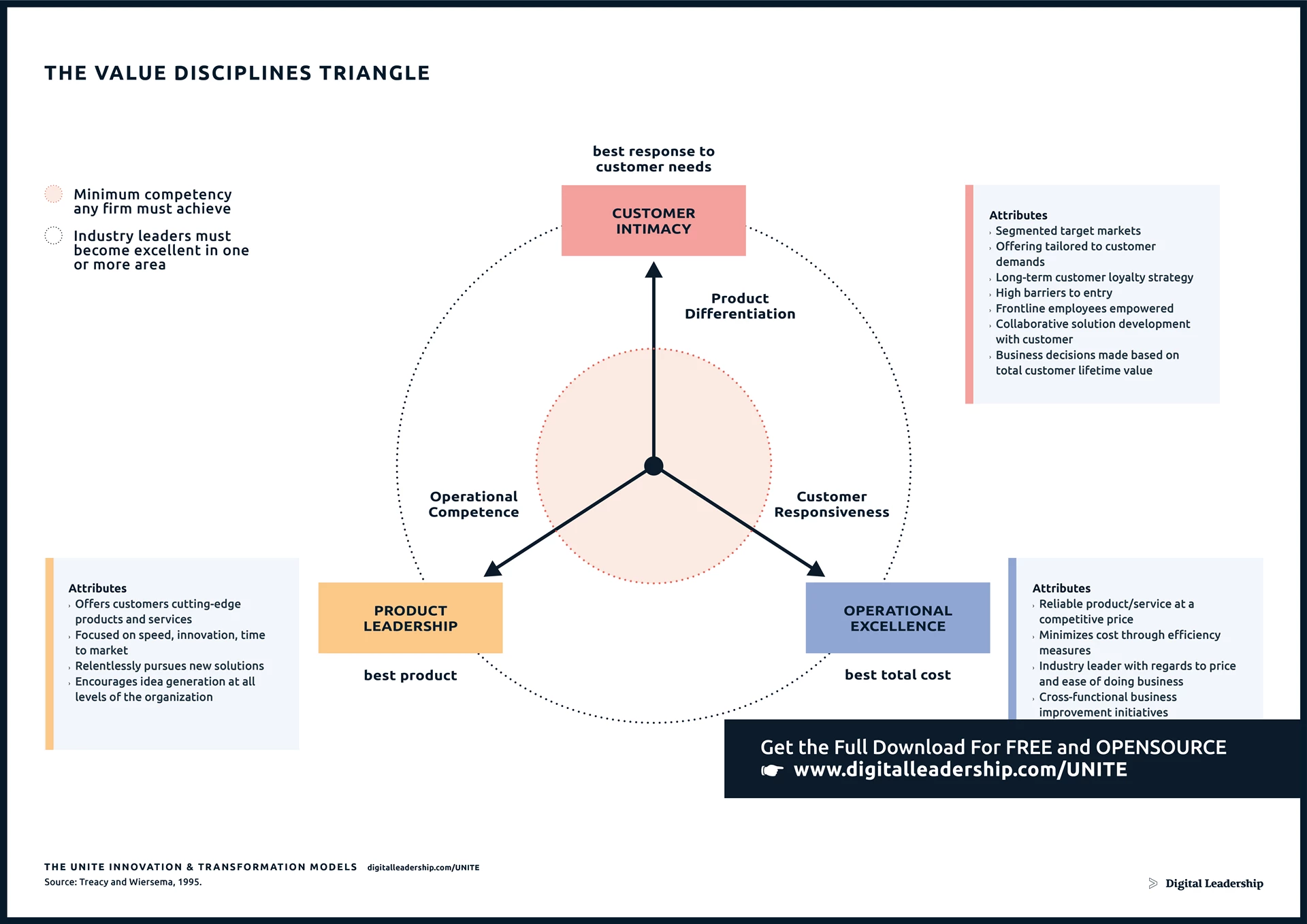Table of Contents
The Operating Model focuses on how your business will deliver value to its customers. In many ways, it’s the most practical segment of the core business model because it outlines day-to-day activities and processes.
Among the tools, a business owner has, Operating Models are among the most useful and most referenced. Successful companies fully understand how their company is impacted by the strategic goals reflected in their Operating Model and how these goals are reflected in their key activities and processes.
What is an Operating Model?

Designed by: Digital Leadership AG – Building on the work of Andrew Campbell at Al.
Your download is now available!
You can now access the complete Operating Model Canvas Package, including a full presentation, related models and instructions for use.
An Operating Model is both an abstract and a visual representation of how an organization delivers value to its customers or beneficiaries. It focuses on how an organization actually runs itself. The concept of an Operating Model Canvas was originally developed by Andrew Campbell and his colleagues. We have developed an iteration of it that will consider additional aspects more geared towards innovation.
The Operating Model Canvas expands upon the Value Chain, Key Resources, and Key Partners of your Business Model.
The Operating Model Canvas will help your team achieve alignment with your strategy and with each other, thus bringing together all the different functions of your business.
The Integration of the UNITE Business Model Canvas and the Operating Model Canvas
The Operating Model Canvas grows from the left-hand side (or back end) of the Business Model Canvas.

Designed by: Digital Leadership AG – Building on the work of Andrew Campbell at Al.
Your download is now available!
You can now access the complete Relation Between Business Model Canvas and Operating Model Canvas Package, including a full presentation, related models and instructions for use.
The Operating Model Canvas thus expands upon the Value Creation aspects of the Business Model. So, when you need to focus on putting your strategic goals into action, just replace the more abstract Value Creation aspects of the Business Model Canvas with the more detailed elements of the Operating Model Canvas.
Operating Model “Main Value Chain”
Value Delivery Chains represent the core processes of your business. The central Value Delivery Chain(s) describes how to deliver the Value Proposition to the target customer. In other words, these core processes directly deliver value to your customers. You may delineate several Value Delivery Chains if you have more than one. A business is not necessarily limited to just one Value Chain!
The other areas are supporting processes. These are necessary but focus on internal customers and processes as opposed to external ones. The supporting processes depicted at the top of the operating model canvas cover the firm infrastructure, organization, partners, and locations, while the supporting areas at the bottom of the canvas focus on HR, management systems, finance, legal, and information.
Logistics
Define the process by which you want to get logistics (especially the logistics of physical items like material handling, production, packaging, inventory, transportation, and warehousing) under control. While it is a key process, it is often not a core activity, because it is rare that you can differentiate yourself with better logistics. It is often the case that a company is too small to handle logistics in-house, so this is a great activity to outsource. Always choose a firm that is best-in-class. Don’t rely on your parent organization for these kinds of activities. They are probably not best-in-class in this particular domain, and they don’t want to deal with the small volume of products you will be starting with.
Operations
You want to be sure of what you really need before you start to build it. The processes of a large organization are built for its purposes and needs. Even if the parent company has the necessary know-how, it may be too slow, too complicated, or too expensive for your purposes.
Unfortunately, many companies see this differently and work towards the mutualization of resources in order to cut costs. This either props up an innovation that wasn’t a great idea in the first place or hinders an innovation initiative that otherwise may have been successful by chaining the innovation speedboat to the lumbering containership of your parent organization. Avoid both by keeping the two horizons separate.
Products Management
Your product is still highly immature and likely not profitable. Yet. Continue to refine and experiment with the Value Proposition, your channels, your customer relationships, and your audience. Also work on pricing, bundling, packaging, partners, and your sales approach. Keep building and shipping, and make sure to maintain a fast iteration cycle with real market feedback.
Technology
Focus on the key issues first. Carefully consider whether it is time to invest your organization’s resources in large infrastructures. Start building up the required back-end processes and infrastructure (but do the exercises manually first to learn what you really need!). This will involve getting in place core systems such as CRM (you want to know your customers!), ERP, and other systems which you may require to scale your company.
Marketing Communications & Sales
Customer service may be a source of differentiation, or it may be best to outsource it. Regardless, think about how you want to run it. For example, customer service via chat is seven times more cost-efficient than running a call center. If customer service is an area where you want to differentiate, think about the most effective ways to do so given your business concept.
Customer Services
Customer service may be a source of differentiation, or it may be best to outsource it. Regardless, think about how you want to run it. For example, customer service via chat is seven times more cost-efficient than running a call center. If customer service is an area where you want to differentiate, think about the most effective ways to do so given your business concept.
Supporting Areas
Located at the top and bottom of the canvas, the Supporting Areas refer to the elements of your operations that need to be in place for you to succeed.
Firm infrastructure & Location
What is the required firm infrastructure, the virtual or physical office, software, structures, and operating infrastructure?
Organization
How do you want to design the core business—the Value Delivery Chains? What kind of structure will you set up? A classical pyramid? A circular model (such as holacracy)? A matrix?
Suppliers & Partners
Who and what contributes to your differentiation and your core activities? What are your supply chain vulnerabilities? What is your relationship with external suppliers?
Human Resources
Who needs to be in place to properly care for the people in your business?
Management Systems
What sort of CEO do you need to best serve where the company is right now?
Finance & Legal
Do you need expensive legal services (probably now!) and where can contracts be kept simple and easy and in-house?
Information
What data, information, and IT applications do you need to support each process? How do you integrate these applications and how do you aggregate them into overarching dashboards that everybody can have access to on a daily basis? Which applications need to be integrated? Which really needs to be bespoke rather than standard, and who owns the data and applications?
Business Operating Model Framework
Aligning Strategy, Business Model, and Operating Model
The Operating Model Canvas is used in a similar way to the Business Model Canvas (or any other canvas). Get together around a flip chart or whiteboard. Write out the areas of the canvas and fill those areas with Post-it notes discussing the critical aspects and how everything fits together. It is typically helpful to start with the core Value Delivery Chain(s). Then move on to what your next biggest challenges are. Do not get dogmatic about the fill order; there is no single best way.
The core strength of the Operating Model Canvas is its brevity. It intentionally does not touch upon every aspect of Value Creation but rather forces you to focus on the key elements and to consider, at the highest level, how the different aspects of the organization fit together. This enables the execution of your strategy and helps to achieve alignment at a high level. It will also help you consider different alternatives for scaling.
For example, you might consider outsourcing most aspects and conducting only partner management and marketing in-house. This is dramatically different from an approach where you do everything in-house!
Of course, once you have agreed upon a high-level target Operating Model, you may then expand it to a 10-page document, by taking the different sections of the canvas and detailing them more fully. But don’t go overboard. There are Operating Models of 100 pages and operating manuals of more than 1000 pages, but this will go too far (at least initially). At this point, we just want to get a strong foundational sense of how we are going to execute our strategy.
Building your Operating Model
There are several items to consider when completing your canvas and reflecting on your current organization:
- Define your operating model design principles
- Identify the value chain(s)
- Identify the capabilities required to deliver the value chains
- Identify Capabilities makeup process
- Organizational structure, roles, and skills of the human resources
- Organize the resources to support the HR doing the work
- Identify a Management system to support the planning and performance
Value Disciplines Triangle
The Value Disciplines triangle, building on Porter’s Generic Strategies, helps you choose which of the three areas you want to focus on: Customer Intimacy, Operational Excellence, or Product Leadership. It’s helpful to understand more about each of these segments.

Designed by: Digital Leadership AG – Source: Treacy & Wiersema, 1995.
Download the complete Value Disciplines Triangle Package, including instructions for putting it to work for you today.
Customer Intimacy: the best response to customer needs
Consider the following:
- Segmented target markets and customer segments
- Offering tailored to customer demands
- Long-term customer loyalty strategy
- High barriers to entry
- Frontline employees empowered
- Collaborative solution development with customer
- Business decisions are made based on total customer lifetime value
Operational Excellence: the best total cost
Includes the following:
- Reliable product/service at a competitive price
- Minimizes cost through efficiency measures
- Industry leader with regards to price and ease of doing business
- Cross-functional business improvement initiatives
Product Leadership: the best product
Consider the following:
- Offers customers cutting-edge products and services
- Focused on speed, innovation, time to market
- Relentlessly pursues new solutions
- Encourages idea generation at all levels of the organization
In the beginning, your leadership team should choose to prioritize one piece of the triangle for targeted success. There are two reasons for this:
- From an organizational perspective, you don’t have the resources to fund being the best in all three categories—in other words, you can’t fully tailor and customize your products (Customer Intimacy), be the cheapest (Operational Excellence), and have the best products (Product Leadership).
Related: The Value Disciplines Model – Choosing the right Value Discipline
- From an external perspective, customers want to know what sets your company apart; is it technical excellence or great customer service? Focusing on one strategic choice allows you to differentiate yourself as you are getting the company off the ground.
Connecting The Dots: The UNITE Business Model Framework
“How to Create Innovation” includes a number of canvases that focus on value creation and finding the right business model to meet your customer segment and customer needs. The framework is built to inspire drastic changes that help you find a competitive advantage. Our hope is that your company grows through business model innovation, and so we again encourage you to look deeper into our website and the book.
Here is a summary of the key ingredients of the framework:

Designed By: Digital Leadership AG
Download the complete Business Model Framework package, including instructions for putting it to work for you today.
Business Models
The centerpiece is the Business Model Canvas, which covers the six main areas of a Business Model (the Operating, Value, Service, Experience, Cost, and Revenue Streams “Models”).
The eXtended Business Model Canvas adds the immediate business context, including Business Drivers, customers, and the team, as well as the Unfair Advantage.
Detailed Models
A Business Model can be broken out into its numerous aspects. Depending on what challenges you face, you can zoom in on your area of interest using an appropriate tool or canvas:
- Your Business Intention and objectives as well as your Massive Transformative Purpose summarize your drivers and give direction to what you do.
- The Value Proposition Canvas details the central components of your offering (the product or service).
- To dig into your Customer Segments, work with data-driven Personas.
- The JTBD Customer Job Statement and Job Map frame the JTBD of your customers.
- The Business Model Environment puts your Business Model in a market context composed of emerging trends and disruptive forces.
- The Innovation Culture Canvas helps you understand and consciously shape a culture that supports innovation.
- The Innovation team structure enables you to draft a team structure for your innovation initiative.
- Using learning and growth metrics, you can measure progress at the initial stages of development. These metrics help you focus on what really matters instead of creating a detailed business plan that will not really help you. Later on, you can expand the financial aspect of the Revenue and Cost Models with a full business case.
- The Operating Model Canvas helps you think through the Operating Model.
Related Models:
- Introducing the UNITE eXtended Business Model Canvas
- Business Capability Map: A Practical Business Approach
- The UNITE Value Proposition Canvas: The Beating Heart of the Business Model
- The Three Horizons of Growth: A Roadmap to Successful Innovation Strategy
- Jobs to be Done Framework, Examples, and Statements (JTBD)
- The UNITE Culture Canvas – Identifying Organizational Culture Critical Elements
- The UNITE Business Model Environment Canvas
- Identifying Hidden Market Opportunities for Innovation through JTBD






























 Book How to Create Innovation
Book How to Create Innovation